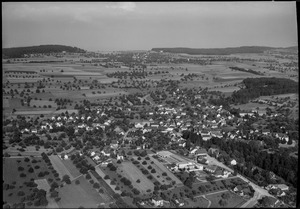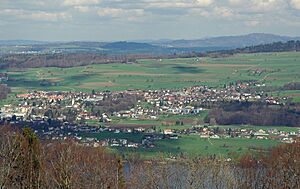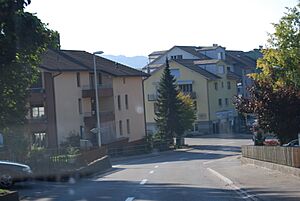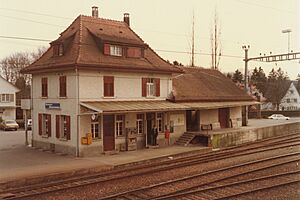Fahrwangen facts for kids
Quick facts for kids
Fahrwangen
|
||
|---|---|---|
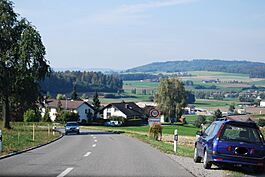 |
||
|
||
| Country | Switzerland | |
| Canton | Aargau | |
| District | Lenzburg | |
| Area | ||
| • Total | 4.01 km2 (1.55 sq mi) | |
| Elevation | 543 m (1,781 ft) | |
| Population
(Dec 2020 )
|
||
| • Total | 2,338 | |
| • Density | 583.0/km2 (1,510.1/sq mi) | |
| Postal code |
5615
|
|
| Surrounded by | Aesch (LU), Beinwil am See, Bettwil, Meisterschwanden, Sarmenstorf, Schongau (LU) | |
Fahrwangen is a small town, also called a municipality, in Switzerland. It is located in the Lenzburg area, which is part of the canton of Aargau.
Contents
A Look Back: Fahrwangen's History
People have lived around Fahrwangen for a very long time! We know this because old items from the Neolithic (New Stone Age), Roman times, and the Alamanni people have been found here.
The name Farnowanch was first used in the year 924. For a while, the Habsburg family ruled the area. Later, the Lords of Hallwyl took over. Under their rule, and then under the city of Bern, Fahrwangen had its own special court system.
The Girls' Sunday Tradition
Something really interesting happened during the second Villmergen War in 1712. Fahrwangen was a camp for the Protestant soldiers. When the Catholic soldiers attacked, a legend says that the women of Fahrwangen and a nearby village called Meisterschwanden bravely joined the fight.
The Protestant soldiers from Bern were so impressed by the women's courage. They decided to give the women a special day where they could be in charge! Since then, on the second Sunday in January, they celebrate Meitlisunntig (Girls' Sunday). On this day, women from both villages run through the streets with nets. If they catch a man in a net, he has to pay a "ransom" to get free. This ransom is often in the form of drinks!
Fahrwangen has had its own district school since 1920. For a long time, the town's church was part of other parishes. But after 1817, Fahrwangen got its own Reformed church parish, which also included Meisterschwanden.
How Fahrwangen Grew
For many years, Fahrwangen was mostly a farming village. But in the 1700s, people started weaving cotton at home. In the 1800s, straw plaiting (making things from woven straw) became popular, both at home and in factories.
In the 1900s, more different types of factories and businesses came to Fahrwangen. Many people in the town still work in industry today. Since the 1980s, more people who live in Fahrwangen travel to other towns for work than people who come into Fahrwangen for jobs.
Fahrwangen's Location and Land
Fahrwangen is located in the southern part of the Lenzburg area. It sits in the Seetal valley, which is east of the Hallwilersee lake. The town is also right next to the border of the Luzern canton.
You'll find Fahrwangen at the bottom of the Lindenberg mountain, in a small dip in the land above Hallwilersee lake. The village itself is built in a somewhat unplanned way, with buildings close together around a central area.
Fahrwangen covers an area of about 3.99 square kilometers (about 1.5 square miles). A big part of this land, about 56.6%, is used for farming. Forests cover about 24.8% of the area. The rest of the land, about 17.3%, has buildings or roads on it. There are also some small rivers and streams.
Fahrwangen's Coat of Arms
The blazon (description) of Fahrwangen's coat of arms is: Per fess Or a lion passant Gules and of the last. This means it has two main parts. The top part is gold (Or) with a red (Gules) lion walking. The bottom part is also red.
Who Lives in Fahrwangen?
Fahrwangen has a population of about 1,724 people. About 20% of the people living here are from other countries. Most people in Fahrwangen speak German (about 89%). Italian is the second most common language, and Turkish is third.
Age Groups in Fahrwangen
Here's a look at the different age groups in Fahrwangen:
- About 9.5% of the population are children aged 0 to 9 years old.
- About 13.8% are teenagers aged 10 to 19.
- About 13.7% are young adults aged 20 to 29.
- About 10.9% are adults aged 30 to 39.
- About 18.0% are adults aged 40 to 49.
- About 13.6% are adults aged 50 to 59.
- About 9.5% are older adults aged 60 to 69.
- About 6.6% are seniors aged 70 to 79.
- About 3.7% are very old seniors aged 80 to 89.
- And about 0.7% are 90 years old or older!
Many homes in Fahrwangen are owned by the people who live in them. In 2008, there were 356 single-family homes in the town.
Population Over Time
Here's how Fahrwangen's population has changed over the years:
| Historical population | ||
|---|---|---|
| Year | Pop. | ±% |
| 1693 | 260 | — |
| 1798 | 529 | +103.5% |
| 1850 | 782 | +47.8% |
| 1900 | 1,019 | +30.3% |
| 1950 | 1,052 | +3.2% |
| 1980 | 1,210 | +15.0% |
| 2000 | 1,653 | +36.6% |
Jobs and Work in Fahrwangen
In 2005, about 59 people in Fahrwangen worked in the primary economic sector. This means they worked in things like farming. There were 19 businesses in this area.
About 348 people worked in the secondary sector, which includes manufacturing and factories. There were 24 businesses in this sector.
Another 232 people worked in the tertiary sector, which includes services like shops, offices, and schools. There were 66 businesses in this sector.
Many people who live in Fahrwangen travel to other towns for their jobs. About 8.4% of working people use public transportation, and 53.9% use a private car to get to work.
Religion in Fahrwangen
Based on a 2000 count, about 40.1% of people in Fahrwangen were Roman Catholic. About 37.1% belonged to the Swiss Reformed Church. There was also one person who belonged to the Christian Catholic faith.
Learning and Education
Switzerland is known for its good education system. In Fahrwangen, many adults (aged 25–64) have finished high school or gone on to higher education, like university.
In the 2008/2009 school year, there were 132 students in primary school in Fahrwangen. There were also 153 students attending university-level schooling in the municipality.
Fahrwangen has a local library called Gemeindebibliotheken und Schulbibliotheken. In 2008, the library had over 7,000 books and other items. It loaned out more than 22,000 items that year! The library was open for 280 days and for about 7 hours each week.
See also
 In Spanish: Fahrwangen para niños
In Spanish: Fahrwangen para niños





